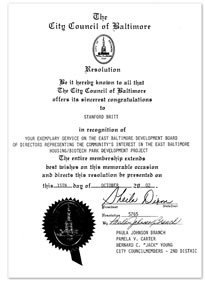

12/2004
 The
AIA Board of Directors named Stanford R. Britt, FAIA, the recipient of
the 2005 Whitney M. Young Jr. Award on December 2. Given to an architect
who exemplifies the profession’s responsibility to society, the
Whitney Young Award honors the former head of the Urban League who, at
the 1968 AIA national convention, reproached the audience of architects
for their lack of civic responsibility and challenged them to become
a positive force for social change: “You are not a profession that
has distinguished itself by your social and civic contributions to the
cause of civil rights. You are most distinguished by your thunderous
silence and your complete irrelevance.”
The
AIA Board of Directors named Stanford R. Britt, FAIA, the recipient of
the 2005 Whitney M. Young Jr. Award on December 2. Given to an architect
who exemplifies the profession’s responsibility to society, the
Whitney Young Award honors the former head of the Urban League who, at
the 1968 AIA national convention, reproached the audience of architects
for their lack of civic responsibility and challenged them to become
a positive force for social change: “You are not a profession that
has distinguished itself by your social and civic contributions to the
cause of civil rights. You are most distinguished by your thunderous
silence and your complete irrelevance.”
Throughout his career, Britt has worked tirelessly to ensure that architecture benefits all communities. He has demonstrated exceptional leadership in making architecture accessible to persons and communities that traditionally have had limited access to the profession. His efforts have stimulated awareness, increased involvement of minorities in the field, and bettered the lives of residents in the communities he has served. “Stan Britt is more than deserving of the Whitney M. Young Jr. Award,” wrote Marshall E. Purnell, FAIA, in his nominating letter. “He is what Whitney Young saw in what this profession could and should be.”
 Lifelong commitment
Lifelong commitment
Britt’s professional commitment to serving those less fortunate
began as a co-operative student at Drexel Institute of Technology in
Philadelphia. There Britt worked for the Young Great Society, a community-based
organization committed to renovating vacant houses and developing vacant
lots in low-income communities. Continuing his education at Columbia
University, Britt worked with the Architects Renewal Committee of Harlem
(ARCH) introducing area high school students to the profession of architecture
and providing counsel to young people working toward their General Education
Diploma.
In 1972, he organized and conducted a Baltimore, Md., urban planning charrette that ultimately fused two community groups—one predominantly Jewish, the other predominantly African American—into one. The Park Heights community of 50,000 residents was the largest urban renewal project in Maryland at the time. The Park Heights Street Academy, an alternative high school, emerged from that charrette. Britt subsequently led the school’s Board of Directors for six years.
Reaching out
Britt believes that the way to achieve a diverse profession is to encourage
diverse people to become active in the profession. To that end, he
has worked tirelessly to bring more minorities into the field of architecture.
He has been a member and leader of the National Organization of Minority
Architects (NOMA) for over 30 years, including serving as its treasurer,
vice president, and president. Additionally, he has been a member and
chair of the AIA Minority Resource Committee and has participated in
a wealth of diversity activities.
As president of the D.C. chapter of the AIA, Britt led the effort to create a scholarship for Washington, D.C., public high school graduates. One scholarship is awarded each year to a college-bound student majoring in architecture. To date, five scholarships have been given. Mary Fitch, AICP, executive director of the D.C. chapter, wrote in her letter of support, “There is no one in Washington who has worked as hard to involve so many different kinds of people in our chapter, from young kids with a dream of studying architecture, to the public, to community leaders who want to make a difference.” Britt also is a member of the Washington Architectural Foundation and an advisor to the national AIA Diversity Committee.
 Community-minded
Community-minded
Britt has volunteered his expertise to numerous community organizations,
including the Baltimore Neighborhood Design Center, a group that provides
architecture and design services to nonprofit organizations. Britt
has recruited minority candidates for universities, AIA committees,
AIA scholarships, and public commissions and boards. He has been a
member of four NAAB accreditation visiting teams and a visiting critic/lecturer
at numerous universities and participated in countless career awareness
programs. In addition, as a firm owner, he has actively sought, interned,
and hired many minorities.
As an active member of the East Baltimore Development Inc. (EBDI) board of directors, Britt currently is working on a project to develop life science research facilities and new housing in this low-income community. As the board representative for the existing residents, he works with EBDI to ensure that a percentage of affordable new housing will be available for existing residents who wish to return to the community upon the project’s completion. This project also provides recreation facilities, job training programs, and a math and science charter school that will put community children on track for careers in the health-care industry. Douglas W. Nelson, president of the Annie E. Casey Foundation, wrote, “Stan has demonstrated unflagging compassion and concern for the residents of East Baltimore. His professional guidance and contributions are critical to creating affordable, low-income housing for the families and individuals of this community who have never really been afforded the opportunity to live the American Dream.”
Britt will receive the 2005 Whitney M. Young Jr. Award at the AIA National Convention and Expo in Las Vegas in May.
Copyright 2004 The American Institute of Architects.
All rights reserved. Home Page ![]()
![]()
 |
||
The AIA will present Britt with the Whitney M. Young Jr. Award at the AIA National Convention in Las Vegas in May.
|
||